Are you looking for a Japanese home style? This is the Japanese curtains, “noren”. Japanese people use in the house as a door to hide the eyes in bathrooms and kitchens. You can create a panel easily with using Japanese fabric.
This article should help you hang Japanese curtains for you!
Sakura Flower Noren Doorway Curtain
Also,if you’ve traveled to Japan, you’ve probably seen the short Japanese curtains doorway on the restaurant. You can hang it on the wall as an interior decoration. This is my favorite beckoning cat (maneki neko).
Today, I will introduce you to the Japanese curtain history, types, uses, and the meaning of the curtain patterns for choosing your best noren.
Table of contents
What is Japanese curtains?
Background of Japanese curtains,noren
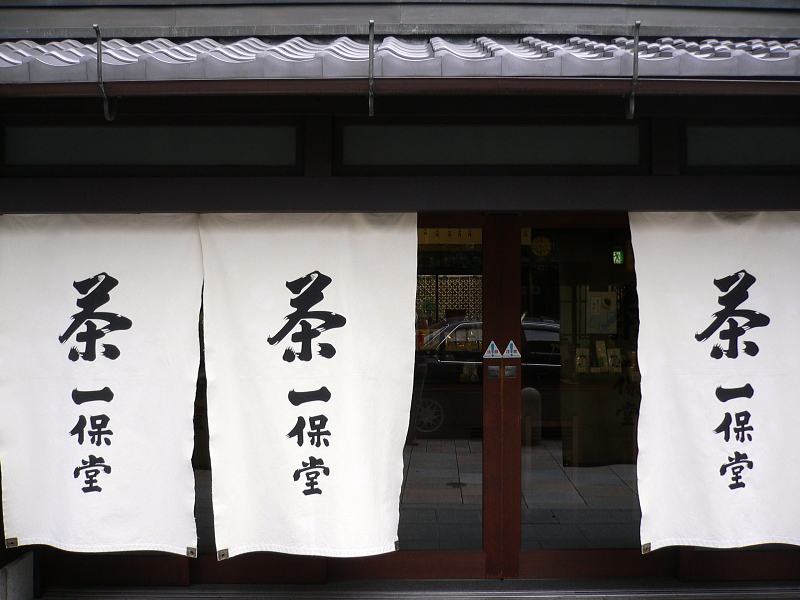
Noren was originally placed outdoors to prevent wind and light from entering directly into the house, or as a blindfold. In Japan, noren is hung up when a store opens, and when it closes, it is put away. This is a signal that the store is open or closed. In the old days, the color of the noren was determined by the type of business. For example, sake brewers and kimono shops used indigo noren, white noren was used for sweets and food shops. And most of noren were plain at first, after the Kamakura period (1185-1333), designs were added to convey a message.
How to hang Japanese curtains?
It is easy to use. First, decide where you want to hang the curtain. Please check Nipponcraft, where there are photos of several example installations. My recommendation is to hang it in line with the door. The beauty of using Noren as a partition is that it can gently block people’s line of sight. If you completely block the space with a door, the space will be completely blocked off, but Noren is a thin fabric, so it can be used to mildly divide the space. For example, instead of closing a door completely, a noren can be hung inside to improve ventilation. Then, it is also recommended to use it to blindfold a pantry with a lot of stuff.
Choose Your Best Japanese Curtains
Here are some recommendations for each of the three types. I hope you will also take notice to the message of noren. Which one is the best fit for your home?
Japanese simple style
The simple Japanese style is very popular in Japanese rooms here in Japan. Many of the designs are easy to blend with other decorations.
Vertical Stripe Noren
This vertical stripe pattern is not only used for noren, but is also a traditional pattern seen in many Japanese kimonos. Indigo is also a very traditional color in Japan. Indigo noren is used by sake brewers and kimono shops to create a formality impression.
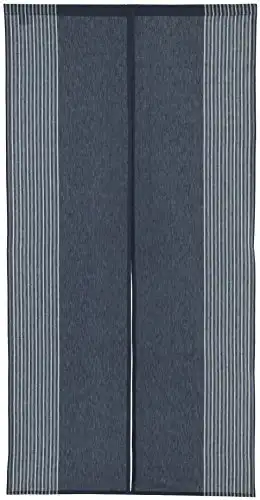 Vertical Stripe Cotton Cloth Japanese Noren Curtain Tapestry (Navy Blue)
Vertical Stripe Cotton Cloth Japanese Noren Curtain Tapestry (Navy Blue)
- Size: width 85cm (33 inches) x length 170 cm (66 inches)
- Weight: 0.3kg (0.66 pounds)
- Material: Cotton, Country of origin: India
- Japanese Noren Curtain Tapestry has a slit in the center. It is not effective in blocking cold or warm air.
- Japanese Noren Curtain Tapestry does not have a shading function.
Old coin pattern Noren
This is a noren with a picture of Kan’ei Tsuho (old coin). This square coin was used in the Edo period (1603-1968) in Japan. The color is the traditional indigo, but if you look closely, you can see various blue colors folded together, which is beautiful.
 Japanese Style Noren Doorway Curtain Six Coins Pattern
Japanese Style Noren Doorway Curtain Six Coins Pattern
- Size:85x150cm/33.5x59inch
- Made of cotton and polyester, a soft and medium thick material. Unique elegant color and design on one side.
- The curtain will split into two parts when entering, which means bringing good luck.
Ink Cat Black and White Noren
This is a simple, white curtain with a cute cat and dragonfly drawn in ink. Suiboku-ga is a simple but profound painting that uses ink in various shades, light and dark.
In Japan, dragonflies are called “victory insects” because they only move forward, and their eyes are large and powerful. Also, the kanji ”幸” means happiness, so it’s very auspicious.
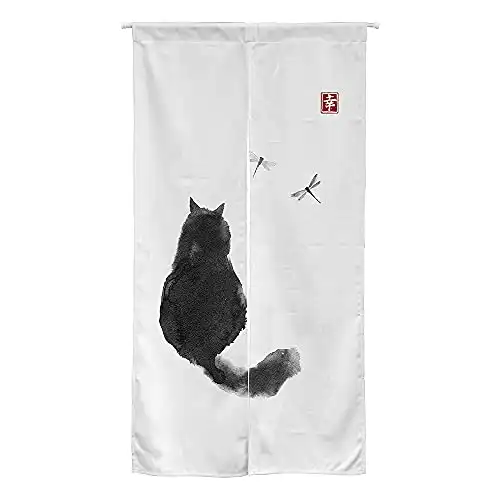 Ink Cat Black and White Noren Doorway
Ink Cat Black and White Noren Doorway
- Eco Friendly Material: odorless reusable polyester with good drapability. One side printed, HD-Printing technology never fade / pilling / shrink after washing. If you need two sides to be printed, please contact us to customize.
- Size: 33.5 W x 59 H inches or 85 W x 150 H cm. The door curtain will split into two parts for entering, which means bringing good luck. We also have a customized service any size or your favorite picture will do please email us with the details.
Enso circle Noren
Enso is one of the calligraphic styles in Zen. It is a circle written in a single stroke with a brush. It is expressed as a connected circle with no beginning or end.
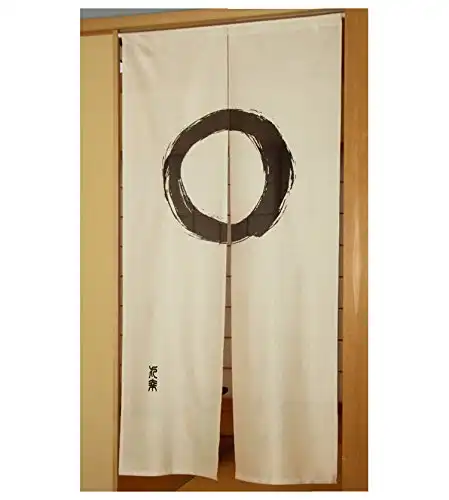 Fukui Textile Factory Noren Curtain Tapestry Enso Circle Beige Long Type
Fukui Textile Factory Noren Curtain Tapestry Enso Circle Beige Long Type
- Polyester
- Imported
- Japanese Noren Curtain Long Type
- Material: Polyester
- Size:W850×H1700(33.5"×66.9")
- Made in Japan
- ※This product does not contain the Noren pole.
It is said that the circle represents the infinite, enlightenment, psychology, and the universe as a whole. The circle is also a reflection of the viewer’s mind, so hanging it in your home may help you to reflect on yourself every day.
▶If you want to learn more about Zen, check out this article.
Japanese Brilliant style
Noren with brightly colored Japanese scenery and motifs, will make your room look gorgeous. Let’s decorate your Japanese space with the vivid beauty of Japan.
Cranes Printed
This curtain has a beautiful crane printed on the curtain. The crane is a very symbolic bird in Japan, and the cloud that appears with cranes is also a sign of good fortune, called 瑞雲(zuiun). And the crane represents abundant life force and longevity, making it a very auspicious pattern. In addition, it is said that once a crane becomes a couple, it will not change its partner for the rest of its life. From this, it has come to mean that the couple can be in harmony with each other forever. It is a very good pattern for couples.
 Japanese Noren Traditional Painting Red Crowned Crane
Japanese Noren Traditional Painting Red Crowned Crane
- Eco Friendly Material: odorless reusable polyester with good drapability. One side printed, HD-Printing technology never fade / pilling / shrink after washing.
- Size: 33.5 W x 59 H inches or 85 W x 150 H cm. The door curtain will split into two parts for entering, which means bringing good luck. We also have a customized service any size or your favorite picture will do please email us with the details.
Kyoto Geisha Girls at Fushimi Inari
If you’ve ever been to Kyoto, Fushimi Inari was probably a must-visit spot. This work of art depicting a geisha passing through the path of the torii gate is beautiful. In Japan, it is said that the nape of the neck is one part of a woman’s beauty. The value of feeling sexy in the beauty of the neckline behind the raised hair has been passed down to the present day in Japan.
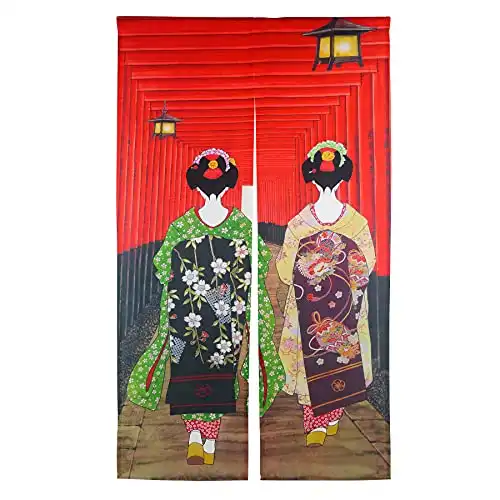 Kyoto Geisha Girls at Fushimi Inari Shrine Long Type Door Tapestry for Home Decoration 33.5 x 59 inch
Kyoto Geisha Girls at Fushimi Inari Shrine Long Type Door Tapestry for Home Decoration 33.5 x 59 inch
- Size: 33.5”x 59” (85 x 150 cm)
- Made of excellent fabric, durable and no color fading, pattern printed only on one side. It can be split into two parts and you can walk right through the middle of the noren curtain, which means bringing good luck.
Japanese season style
The Japanese value the four seasons very much. We change the decoration of the house every season to enjoy the flowers, trees and seasonal scenery. Do you want to enjoy the Japanese style of the four seasons?]
Spring
Cherry blossom (Sakura 桜)
Spring in Japan means cherry blossoms. The light pink Sakura curtain will warm up your room. Why do Japanese people love cherry blossoms so much? It’s because we have a view of life and death that sees the beauty in the shortness of life, as beautiful flowers bloom in an instant and fall away in a week or so. This is why we have long been loved by the Japanese people as something sacred.
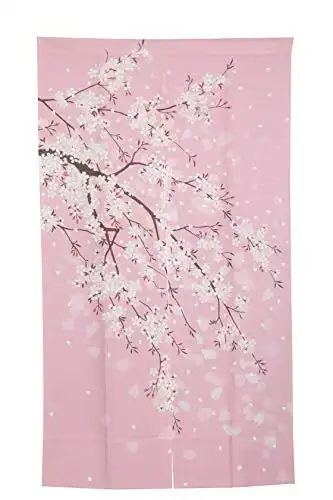 Cherry Blossom Japanese Noren Doorway Curtain
Cherry Blossom Japanese Noren Doorway Curtain
- Material: Polyester (cotton With Polyester)
- Size: 59"x33.5"
- Nice curtains for doorways.
Wisteria(Fuji 藤)
The cherry blossoms are too famous, but the wisteria flowers here are also spring flowers. It is a beautiful light purple flower that comes into full bloom when the cherry blossoms are over. The wisteria is considered a symbol of prosperity and longevity. This beautiful flower blooms downward and is somewhat reserved, quiet and graceful. The word for wisteria is “welcome”. It is a perfect curtain for welcoming guests.
Summer
Golden fish (金魚)
Summer in Japan is all about festivals. Goldfish are an indispensable part of festivals. Every Japanese person has probably had a goldfish in the summer by scooping goldfish at festivals. Therefore, this goldfish curtain conveys the coolness of summer and the beautiful water surface.
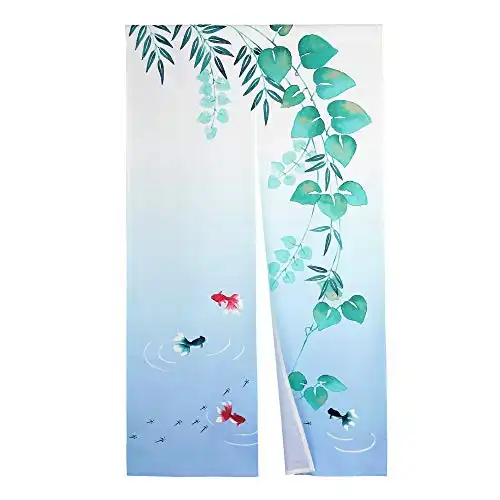 Golden Fish and Green Leaves
Golden Fish and Green Leaves
- Material: Made of light polyester, it gives just the right amount of privacy without having to close a door
- Size: 33 x 59 inch / 85 x 150 cm, perfect size for most doors for home, office and restaurant decoration
- Use it as doorway divider, curtain or wall hanging for decor or as a means of protection from sun, wind, and dust
Autumn/Fall
Moon viewing
The middle of autumn, August 15th of the lunar calendar, is called the “Mid-Autumn Moon” and is the day for viewing the moon. And in Japan, it is said that the rabbit is making rice cakes in response to the pattern of the moon. This curtain beautifully expresses this autumnal scene.
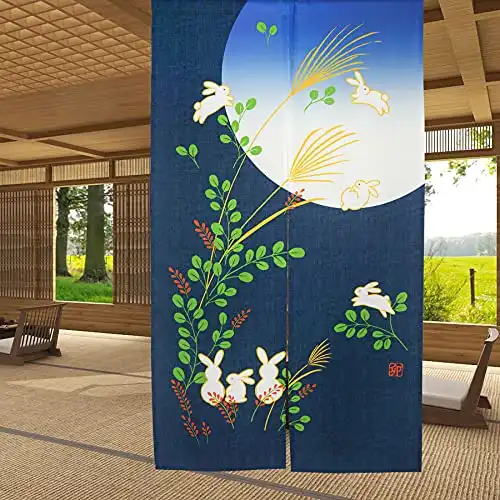 LIGICKY Japanese Doorway Curtain Noren Cute Rabbit Under Moon Decoration Blue
LIGICKY Japanese Doorway Curtain Noren Cute Rabbit Under Moon Decoration Blue
- 100% Polyester
- Size:85*150cm/ 33*59inch
- Doorway curtain is often hung on the door for home, office and restaurant decoration.
Red fuji
Why this curtain for fall? You may be wondering. Mt Fuji, the tallest mountain in Japan, turns red in the morning sun in late summer and early autumn. Red Fuji is rarely seen, s It is said that decorating with indoor decorations is good for Feng Shui. It is also said to bring good luck to people who wish to escape from bad luck or prosper in business.
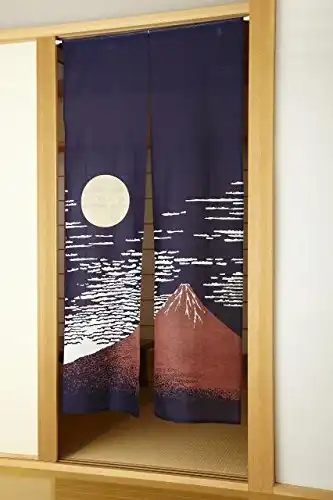 Akafuji Noren Curtain Tapestry Long Type
Akafuji Noren Curtain Tapestry Long Type
BrandFukui Textile FactoryColorIndigoMaterialPolyesterProduct Dimensions33.46"L x 33.46"WOpacityLight-filtering
Winter
Nanten&Camellia (南天&椿)
This red fruit is called “Nanten”. Nanten is often used for New Year’s decorations, and has the good meaning of “turning a difficult situation around. The camellia is a flower that blooms around the time of the arrival of spring. Camellias have been used to ward off evil spirits. And camellia is a very popular pattern for kimonos.
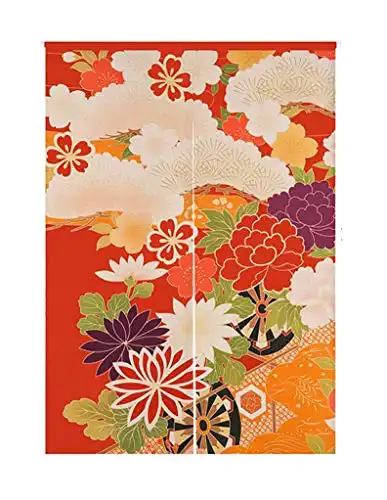 Japanese Style Doorway Curtain Noren Cotton Linen Retro Flowers Printed
Japanese Style Doorway Curtain Noren Cotton Linen Retro Flowers Printed
- ✤Size: 33.5” x 47.2" (85 x 120 cm)
- ✤Made of excellent thick cotton linen material, durable and no color fading, pattern printed only on one side. It can be split into two parts and you can walk right through the middle of the noren curtain, which means bringing good luck.

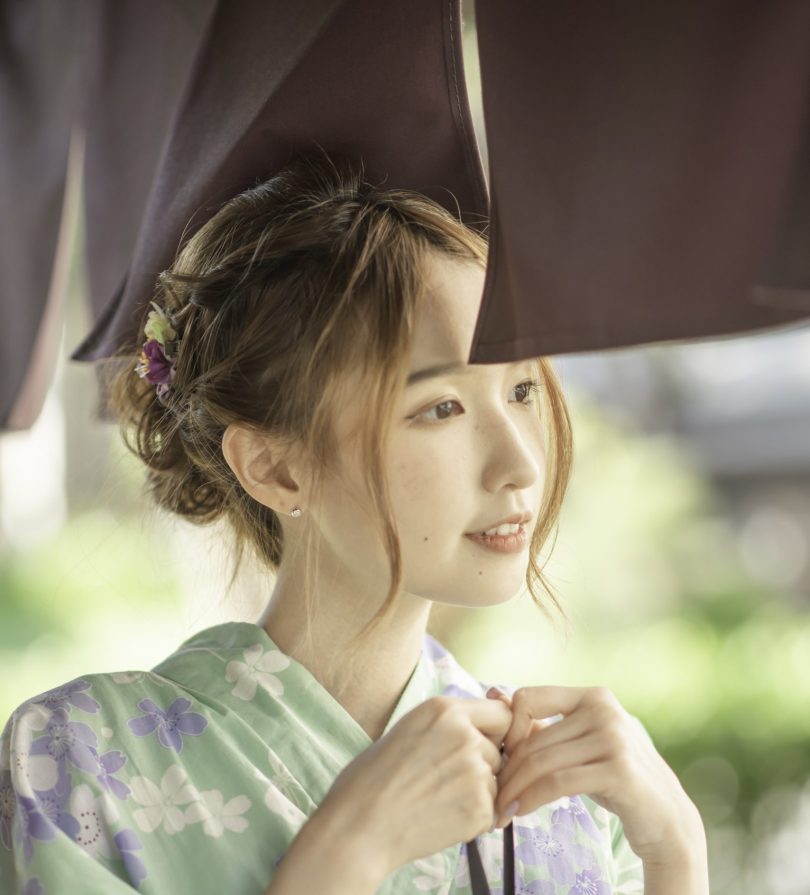
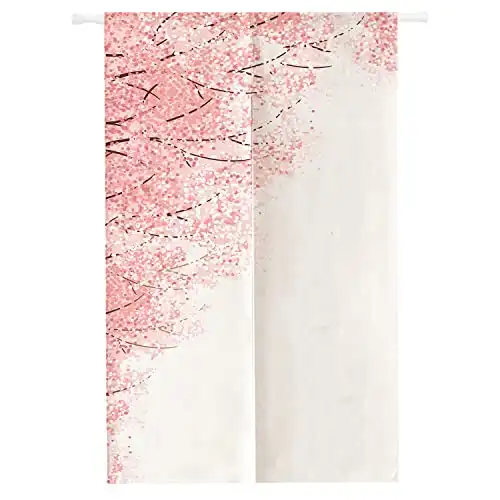
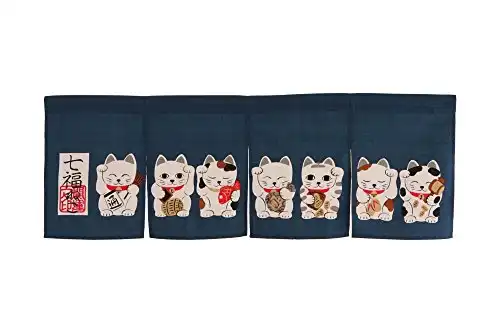

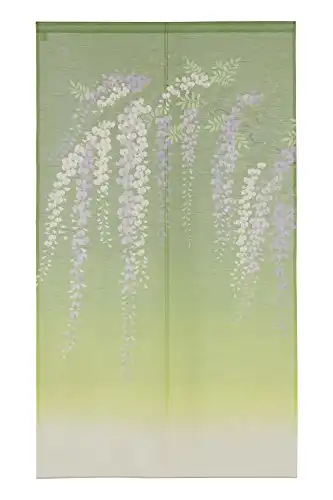

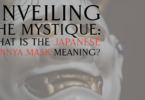
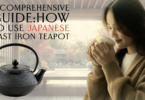


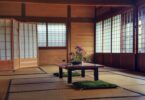
Great content!